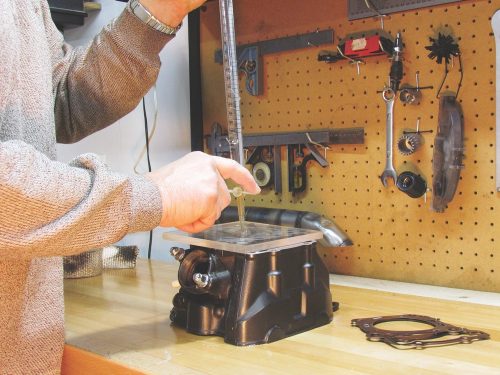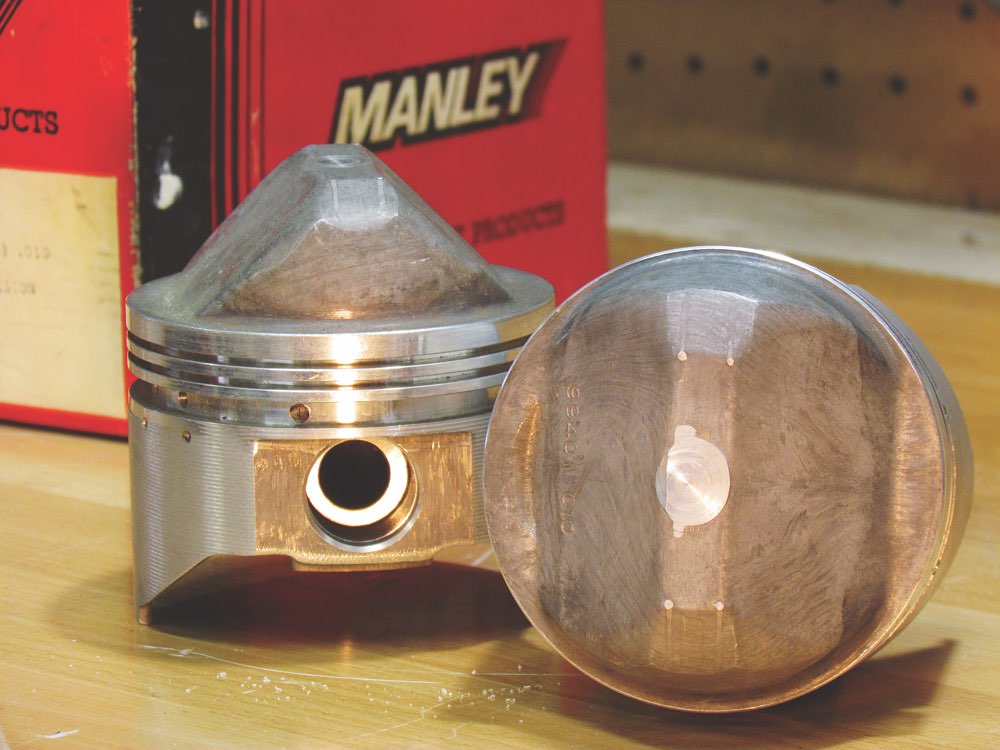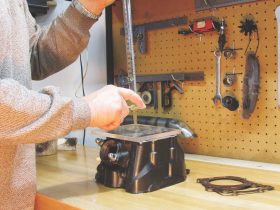It can be a complicated process to determine a compression ratio.
Power transfers to the rear wheel of a motorcycle by burning an air/fuel mixture in the combustion chamber of a cylinder, and the expansion of the burning gasses pushes on the piston, which turns the crankshaft that eventually propels you forward. The more efficiently the fuel mixture burns, the harder the push on the piston will be, and the more power that will be produced.
 Aside from factors like cubic displacement, and intake and exhaust design, an engine’s compression ratio has a great effect on output and fuel efficiency. The compression ratio is the ratio between the total volume of a cylinder when the piston is at the bottom of its stroke and the volume of the combustion chamber when the piston is at the top of its stroke, including the head gasket thickness and the shape of the top of the piston. Therefore, if the total volume of the cylinder is 100 cc, and the volume with the piston at top dead centre (TDC) is 10 cc, you have a mechanical compression ratio of 10:1.
Aside from factors like cubic displacement, and intake and exhaust design, an engine’s compression ratio has a great effect on output and fuel efficiency. The compression ratio is the ratio between the total volume of a cylinder when the piston is at the bottom of its stroke and the volume of the combustion chamber when the piston is at the top of its stroke, including the head gasket thickness and the shape of the top of the piston. Therefore, if the total volume of the cylinder is 100 cc, and the volume with the piston at top dead centre (TDC) is 10 cc, you have a mechanical compression ratio of 10:1.
Put simply: the higher the compression ratio, the more power will be produced for a given displacement, and for a given amount of fuel. This is because the more a fuel mixture is compressed, the more complete it will burn and expand. However, it gets a bit more complicated than that in practice, and there are more factors working against a high compression ratio than there are benefits.
The biggest detrimental factor is “detonation.” This is when a fuel mixture ignites elsewhere in the combustion chamber other than at the spark plug when it fires. So, instead of a well-timed expansion of gasses that begins burning when the spark plug fires as the piston nears TDC, and continue expanding as the piston begins to move back down, there’s a blast that hits the piston like a hammer blow while it is still on the upstroke. This is where engine “knock” comes from, and it is very damaging.
A mixture can ignite prematurely due to the type of fuel (higher-octane fuels resist detonation), ignition timing (advanced timing gives the mixture more time to experience detonation as the piston moves upward) and how much the mixture is compressed (compressing a gas creates heat). Cylinder bore size is also a factor, and the bigger the bore, and subsequently the combustion chamber, the more time it takes for the flame front to travel from the spark plug to the farthest areas of the combustion chamber, thus giving the mixture more opportunity to detonate. For a given engine displacement, an engine with a smaller bore and longer stroke will be less prone to experience knock, because the flame takes less time to fill the combustion chamber. This is why big V-twins and singles are more likely to knock, and why they have lower compression ratios than multi-cylinder engines of similar displacement.
However, it’s not the compression ratio that is the problem, but the higher combustion chamber pressures that are produced by higher compression ratios – higher pressures are conducive to detonation, since as mentioned earlier, compressing a gas creates heat. Compression ratios on modern motorcycles range from as low as 9.5:1, like that on the Suzuki DR650SE, to as high as 14:1, such as on the Ducati Panigale V4. The Kawasaki Ninja H2 has an even lower compression ratio than the DR650, at 8.5:1, but its combustion chamber pressures are very high, because the intake charge is pressurized by a supercharger.
There is no easy way to calculate compression ratio without disassembling the engine. The following are needed to calculate the compression ratio: the actual cylinder bore and stroke measurements, the head gasket compressed thickness, the piston dome volume, the piston deck-height volume (where the top of the piston is in relation to the head gasket surface at TDC) and the combustion chamber volume.
The best way to measure combustion chamber volume is by recording how much liquid it takes to fill it using a 100 cc burette. Piston makers sometimes include piston dome volume, which must be subtracted from the combustion chamber volume; otherwise, you must install the piston and rings into the cylinder and measure the volume with a burette. The formula for calculating the cylinder volume alone, without the combustion chamber, is bore x bore x 12.87 x stroke = volume in cc (bore and stroke measurements in inches). Once you have that volume, and the combined volume of the combustion chamber, head gasket and piston dome, you can calculate the compression ratio by dividing the total cylinder and combustion chamber volume by the combustion-chamber volume (including the head-gasket and piston-dome volume).
Aside from removing material from the head or cylinder, you can raise the compression ratio by installing high-compression pistons or thinner head gaskets, or by replacing the base gaskets with a sealing compound like ThreeBond gasket maker.
Technical articles are written purely as reference only and your motorcycle may require different procedures. You should be mechanically inclined to carry out your own maintenance and we recommend you contact your mechanic prior to performing any type of work on your bike.











